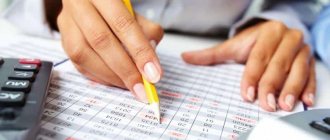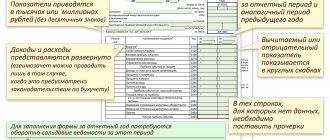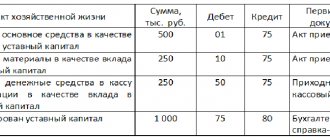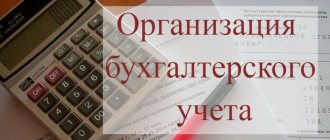In the latest issue of accounting educational program, Alexey Ivanov explains why a balance sheet is needed, what can be seen in it, and why being able to read a balance sheet is important not only for an accountant. At the end of the article there is an example of constructing a balance sheet that will be understandable even to a reader who is very far from accounting.
Hi all! Alexey Ivanov is with you, the knowledge director of the online accounting “My Business” and the author of the telegram channel “Accounting Translator”. Every Friday on our blog on Klerke.ru I talk about accounting. I started with the basics, then I will move on to more complex matters. For those who are just preparing to become an accountant, this will help them get to know the profession better. Seasoned chief accountants should look at familiar categories from a different angle.
Balance sheet - what is it?
An accounting balance sheet is a tabular version of the reflection of an organization’s financial indicators as of a certain date.
In the most widespread form in the Russian Federation, the balance sheet consists of two equal parts, one of which shows what the organization has in monetary terms (balance sheet asset), and the other - from what sources it was acquired (balance sheet liability) . This equality is based on the reflection of property and liabilities using a double entry method in accounting accounts. ATTENTION! From 2021, financial statements will be submitted exclusively in electronic form. Paper forms will no longer be accepted. Read more about changes to the rules for presenting financial statements here. We also remind you that in 2021 the reporting forms have been updated.
A balance sheet compiled as of a specific date allows one to assess the current financial condition of an organization, and a comparison of data from balance sheets compiled as of different dates allows one to track changes in its financial condition over time. The balance sheet is one of the main documents that serves as a source of data for conducting an economic analysis of an enterprise's activities.
Having trouble with your balance? On our forum you can consult on any issue. For example, here you can see whether an explanatory note is needed for the financial statements of a small enterprise.
Presentation methods
In previous years, organizations had a choice of how to submit their balance sheet to the Federal Tax Service: on paper or via the Internet.
But as of reporting for 2021, there is no such choice. From now on, companies have only one option - to submit their balance online (via telecommunications channels through an electronic document management operator). An exception is made only for small businesses. They have the right to report for 2021 both on paper and according to the TKS. They will submit the balance sheet for 2021, like everyone else, online. Such changes were made to the Accounting Law by Federal Law No. 444-FZ dated November 28, 2018.
Having received the report, inspectors analyze it. They examine assets and liabilities and compare them with information reported on tax returns. The structure of the balance sheet allows employees of the Federal Tax Service to get a general idea of the state of affairs of the company.
Latest balance changes
From 06/01/2019, the balance sheet form is valid as amended by Order of the Ministry of Finance dated 04/19/2019 No. 61n. The key changes in it (as well as in other financial statements) are as follows:
- now reporting can only be prepared in thousand rubles, millions can no longer be used as a unit of measurement;
- OKVED in the header has been replaced by OKVED 2;
- The balance sheet must contain information about the audit organization (auditor).
The auditor mark should only be given to those companies that are subject to mandatory audit. Tax authorities will use it both to impose a fine on the organization itself if it ignored the obligation to undergo an audit, and in order to know from which auditor they can request information on the organization in accordance with Art. 93 Tax Code of the Russian Federation.
More significant changes have occurred in Form 2. Read more about them here.
Classification of balance sheets
There are many types of balance sheets. Their diversity is determined by a variety of reasons: the nature of the data on the basis of which the balance is formed, the time of its compilation, purpose, method of reflecting the data and a number of other factors.
According to the way the data is reflected, the balance sheet can be:
- static (balance) - compiled for a specific date;
- dynamic (revolving) - compiled by turnover for a certain period.
In relation to the moment of compilation, balances are distinguished:
- introductory - at the beginning of activity;
- current - compiled as of the reporting date;
- liquidation - upon liquidation of an organization;
- sanitized - when rehabilitating an organization approaching bankruptcy;
- dividing - when dividing an organization into several companies;
- unifying - when organizations merge into one.
Based on the volume of data on organizations reflected in the balance sheet, balance sheets are distinguished:
- single - one organization at a time;
- consolidated - based on the sum of data from several organizations;
- consolidated - for several interrelated organizations, internal turnover between which is excluded when preparing reports.
According to its purpose, the balance sheet can be:
- trial (preliminary);
- final;
- predictive;
- reporting.
Depending on the nature of the source data, there is a balance:
- inventory (compiled based on the results of the inventory);
- book (compiled only according to registration data);
- general (compiled according to accounting data taking into account the results of the inventory).
By way of data reflection:
- gross - including data from regulatory items (depreciation, reserves, markup);
- net - with the exception of these regulatory articles.
Balance sheets may vary depending on the legal form of the company (balance sheets of state, public, joint, private organizations) and the type of its activity (main, auxiliary).
Based on frequency, balances are divided into monthly, quarterly, and annual. They can have either full or abbreviated form.
The balance sheet table can be of 2 types:
- horizontal - when the balance sheet currency is defined as the sum of its assets, and the sum of assets is equal to the sum of capital and liabilities;
- vertical - when the balance sheet currency is equal to the value of the organization's net assets (i.e., the amount of capital), and the net assets, in turn, are equal to the assets of the enterprise minus its liabilities.
For internal purposes, the organization itself has the right to choose the frequency, methods and methods of preparing the balance sheet. Reports submitted to the Federal Tax Service must have a certain form with comparable data as of the dates indicated in the balance sheet.
For information on how to draw up a balance sheet for a small business, read the article “Balance Sheet for Small Businesses (Features)” .
Purposes of compilation and who needs it?
The purpose of drawing up this reporting document is to provide complete, realistic, impartial information about the financial condition of the enterprise as of a specific reporting date.
The information contained in the report is available to various users interested in this data. Among them:
- owners and managers;
- financial and economic department of the organization;
- tax office;
- statistical authorities;
- creditor banks;
- sponsors and investors;
- counterparties, etc.
Structure of the enterprise's balance sheet
The balance sheet form used for official reporting in the Russian Federation is a table divided into two parts: the asset and liability of the balance sheet. The total amounts of assets and liabilities of the balance sheet must be equal.
A balance sheet asset is a reflection of the property and liabilities that are under the control of the enterprise, are used in its financial and economic activities and can bring it benefits in the future. The asset is divided into 2 sections:
- non-current assets (this section reflects property used by the organization for a long time, the cost of which, as a rule, is taken into account in the financial result in parts);
- current assets, data on the availability of which are in constant dynamics, accounting for their value in the financial result, as a rule, is carried out one-time.
Read more about them in the material “Current assets on the balance sheet are...” .
The balance sheet liability characterizes the sources of those funds from which the balance sheet asset is formed. It consists of three sections:
- capital and reserves, which reflect the organization’s own funds (its net assets);
- long-term liabilities, which characterize the debt of an enterprise that has existed for a long time;
- short-term liabilities showing an actively changing part of the organization's debt.
To learn about which entries are used when reflecting equity capital in accounting, read the article “Procedure for accounting for an organization’s equity capital (nuances).”
Applications
In some cases, one or another supplement to the balance sheet may be used. The legislation of the Russian Federation provides for several types of the corresponding document. All of them are presented in the form:
— statement of changes in capital;
— cash flow report;
— report on the intended use of funds.
A specific appendix to the balance sheet can be used based on the specifics of the activities of the enterprise that prepares the appropriate type of reporting. It is possible to use a number of additional documents when preparing the corresponding source. Among these is an explanatory note on the balance sheet. In particular, it deciphers balance sheet indicators, which can significantly increase the loyalty of organizations checking the document.
It is extremely important to correctly fill out the document in question. An assessment of an organization's balance sheet can be made not only by government agencies, but also by interested partners of the company - creditors, investors. It is important that they have at their disposal figures that reflect the real state of affairs in the company.
The balance sheet is a statement that is mandatory for almost every enterprise. This document is necessary to fully reflect the processes that take place within the company, but not everyone has an idea of how to draw it up correctly. This issue is especially relevant for people who have just registered an enterprise and are faced with such a procedure for the first time. Let's look at this question in our article using an example for dummies and try to formulate a number of recommendations that can help in drawing up a balance sheet.
Contents of sections of the balance sheet
The allocation of sections in the structure of the balance sheet is mainly due to the temporary factor.
Thus, the balance sheet asset is divided into 2 sections depending on the time of use of the assets in the organization’s activities:
- non-current assets are used for more than 12 months;
- current assets contain data on indicators that will change significantly over the next 12 months.
When separating sections in the liabilities side of the balance sheet, in addition to the time factor, the ownership of the funds from which the balance sheet asset is formed (equity capital or borrowed funds) plays a role. Taking into account these 2 factors, the liability is formed from 3 sections:
- capital and reserves, where the organization’s own funds are divided into an almost constant part (authorized capital) and a variable part, depending both on the adopted accounting policy (revaluation, reserve capital) and on the monthly changing financial results of activities;
- long-term liabilities - accounts payable that will exist for more than 12 months after the reporting date;
- short-term liabilities - accounts payable, significant changes in which will occur within the next 12 months.
For more information on reflecting revaluation in the balance sheet, see the material “Revaluation of non-current assets in the balance sheet is...”.
How to fill out tables correctly?
Today, there are some rules for filling out the balance sheet. The procedure requires special attention and a responsible approach.
Here you can learn more about preparing tax reports when running an individual entrepreneur.
All information for filling out the report is taken only from official documents. The absence of data allows you not to fill in the corresponding line.
At the end of the document, total indicators expressed in monetary terms should be displayed, which ultimately look like this: Asset = Liability.
The period for which information was collected in the balance sheet must be indicated. It is also necessary to make comparisons with other reporting data.
The concept and meaning of balance sheet items
Sections of the balance sheet are detailed by breaking them down into items. The itemized details recommended for submission to the Federal Tax Service Inspectorate are contained in balance sheet forms approved by Order of the Ministry of Finance of Russia dated July 2, 2010 No. 66n in 2 versions:
- complete (Appendix 1);
- abbreviated (Appendix 5).
The abbreviated (simplified) form of the balance sheet allows for the combination of its articles in order to obtain aggregated indicators and simplify reporting. However, its use is available only to persons entitled to conduct simplified accounting (SMEs, NPOs, participants in the Skolkovo project).
The breakdown of sections into articles is due to the need to highlight the main types of property and liabilities that form the corresponding sections of the balance sheet.
The form of a complete balance sheet recommended by the Ministry of Finance of Russia assumes the following breakdown of sections by item:
- fixed assets:
- intangible assets;
- research and development results;
- Intangible search assets;
- tangible prospecting assets;
- fixed assets;
- profitable investments in material assets;
- financial investments;
- Deferred tax assets;
- Other noncurrent assets;
- stocks;
- VAT on purchased assets;
- accounts receivable;
- financial investments (except for cash equivalents);
- cash and cash equivalents;
- Other current assets;
- authorized capital (share capital, authorized capital, contributions of partners);
- own shares purchased from shareholders;
- revaluation of non-current assets;
- additional capital (without revaluation);
- Reserve capital;
- retained earnings (uncovered loss);
Find out which line shows gross profit on the balance sheet here .
- long term duties:
- borrowed funds;
- deferred tax liabilities;
- estimated liabilities;
- other obligations;
- borrowed funds;
- accounts payable;
- revenue of the future periods;
- estimated liabilities;
- other obligations.
When drawing up a balance sheet, an organization can use the item-by-item detailing recommended by the Russian Ministry of Finance. However, it has the right to use its own development of this breakdown if it believes that this will lead to greater reliability of reporting. In addition, if there is no data to fill out the relevant items, the company has the right to exclude such items from the balance sheet it compiles.
Look at a sample balance sheet prepared by ConsultantPlus experts. Get trial access to the system and proceed to the material. It's free.
What does the abbreviation TZR (decoding) and others mean?
Further in the article, abbreviations that are often used in accounting will be frequently mentioned. But beginners may have difficulty deciphering them, so we will give the full name of such abbreviations:
- TZR - transportation and procurement costs.
- OS - fixed assets.
- R&D - research and development work.
- Intangible assets - intangible assets.
- WIP - work in progress.
- FBP - deferred expenses.
- Commodities and materials - inventory items.
- FSS - social insurance fund.
Composition of balance sheet items
Balance sheet items are filled out based on data on balances in accounting accounts as of the reporting date. When filling out a report for submission to the Federal Tax Service, you must be guided by a number of rules established for the preparation of such reports (PBU 4/99, approved by order of the Ministry of Finance of Russia dated July 6, 1999 No. 43n):
- The initial accounting data must be reliable, complete, neutral and formed in accordance with the rules of the current PBU. When reflecting them, it is necessary to comply with the principles of materiality and comparability with the results of previous periods.
- In the current report, data from previous periods must be consistent with the figures in the final accounts for those periods.
- For the annual balance sheet, the presence of property and liabilities must be confirmed by the results of their inventory.
- Debit and credit balances in the balance sheet are not collapsed.
- Fixed assets and intangible assets are shown at residual value.
- Assets are reflected at their book value (less created reserves and mark-ups).
You can see a detailed line-by-line algorithm for filling out the balance sheet in the Guide to Accounting Reports from ConsultantPlus, having received free access to the system.
And below is information about on the basis of the balances of which accounts the above balance sheet items are filled in in relation to the current version of the chart of accounts, approved by order of the Ministry of Finance of Russia dated October 31, 2000 No. 94n:
- Under the article “Intangible assets”, the residual value of intangible assets is indicated, corresponding to the difference in the balances of accounting accounts 04 and 05. At the same time, for account 04, data falling in the line “Results of research and development” is not taken into account, and for account 05 - figures related to intangible search assets.
- The article “Results of research and development” is filled in if there is data on R&D costs in account 04.
- Data on the items “Intangible exploration assets” and “Tangible exploration assets” are important only for those organizations that develop natural resources if they have information on account 08 to fill out lines for these items. Tangible exploration assets include tangible objects, and intangible assets include all others. Both types of assets are subject to depreciation, recorded in accounts 02 and 05, respectively.
- For the item “Fixed Assets”, data on the residual value of fixed assets (the difference in the balances of accounting accounts 01 and 02, while account 02 does not take into account data related to material exploration assets and profitable investments in assets) and capital investment costs (account 08, excluding the figures included in the lines of the articles “Intangible search assets” and “Tangible search assets”).
- Data for the article “Profitable investments in assets” is taken as the difference between the balances of accounts 03 and 02 in relation to the same objects.
- The item “Financial investments” in non-current assets is filled in if there are amounts with a repayment period of more than 12 months in accounts 55 (deposits), 58 (financial investments), 73 (loans to employees). The balance of account 58 is reduced by the amount of the created reserve (account 59) related to long-term investments.
- Under the article “Deferred tax assets”, organizations applying PBU 18/02 indicate the balance of account 09.
- When the line item “Other non-current assets” is used, the balance sheet reflects assets that are either not included in the above lines, or those that the organization considers necessary to highlight.
- The figure for the item “Inventories” is formed as the sum of the balances on accounts 10, 11 (minus the reserve recorded on account 14), 15, 16, 20, 21, 23, 28, 29, 41 (minus account 42, if accounting for goods carried out with a markup), 43, 44, 45, 46, 97.
- The item “VAT on purchased valuables” reflects the balance of account 19.
- To obtain the data indicated under the “Accounts receivable” item, debit balances on accounts 60, 62 (both accounts minus the reserves formed on account 63), 66, 67, 68, 69, 70, 71, 73 (minus data , recorded under the article “Financial investments”), 75, 76.
- The article “Financial investments (except for cash equivalents)” in current assets shows data on accounts 55 (deposits), 58 (financial investments), 73 (loans to employees) with repayment periods of less than 12 months. In this case, the figures in account 58 are reduced by the amount of the created reserve (account 59) for short-term investments.
- The data for the item “Cash and cash equivalents” is obtained by adding the balances of accounts 50, 51, 52, 55 (excluding deposits), 57.
- The line of the article “Other current assets” includes assets that are either for some reason not reflected in the above lines, or those that the organization considers necessary to highlight. For example, this could be a bad debt from a counterparty or the value of stolen property for which investigative actions have not yet been completed. Reflection of such data on this line with a corresponding reduction in figures for those items in which they could have been reflected if there had not been a decision by the organization to allocate them, will require notes both to the article “Other current assets” and to the second article, which will be affected such an operation.
- The data for the article “Authorized capital (share capital, authorized capital, contributions of partners)” is taken as the balance of account 80.
- The figures in the article “Own shares purchased from shareholders” correspond to the balances of account 81.
- For the article “Revaluation of non-current assets”, data on balances on account 83 related to fixed assets and intangible assets is used.
- Data for the item “Additional capital (without revaluation)” is formed as balances on account 83 minus data on the revaluation of fixed assets and intangible assets.
- The item “Reserve capital” shows the balance of account 82.
- The value reflected under the item “Retained earnings (uncovered loss)” in the annual balance sheet is the balance of account 84. For interim reporting (before the balance sheet reformation carried out at the end of the year), this figure is the sum of two balances: for account 84 (financial the result of previous years) and 99 (financial result of the current period of the reporting year). The item “Retained earnings (uncovered loss)” is the only balance sheet item that can have a negative value. At the same time, it is important that for an organization that has a loss, the total of the “Capital and Reserves” section (net assets) does not turn out to be less than the amount of the authorized capital. If this circumstance occurs for two financial years in a row, then the organization must either reduce its authorized capital to the appropriate figure (and this is not always possible, since the authorized capital cannot be less than the minimum value established by current legislation), or it is subject to liquidation.
ATTENTION! With the reporting campaign for 2021, changes to PBU 18/02, 16/02, 13/2000, FSBU 5/2019 “Reserves” come into effect. And starting with reporting for 2022, the new FSBU 25/2018 “Lease Accounting”, FSBU 6/2020 “Fixed Assets”, FSBU 26/2020 “Capital Investments” should be applied. You can start applying new accounting standards earlier. This decision needs to be fixed in the accounting policy of the enterprise.
Read more about the reformation of the balance sheet in the article “How and when to reform the balance sheet?” .
- The article “Borrowed funds” in the “Long-term liabilities” section is filled in if there is debt on loans and borrowings, the repayment period of which exceeds 12 months (account balance 67). In this case, interest on long-term borrowed funds must be taken into account as part of short-term accounts payable.
- Under the article “Deferred tax liabilities”, organizations applying PBU 18/02 indicate the balance of account 77.
- The value under the item “Estimated liabilities” in the section “Long-term liabilities” corresponds to the balance in account 96 (reserves for future expenses) in relation to those reserves whose useful life exceeds 12 months.
- The item “Other liabilities” in the section “Long-term liabilities” shows liabilities with a maturity of more than 12 months that are not included in other lines of long-term liabilities.
- The article “Borrowed funds” in the “Short-term liabilities” section is filled in if there is debt on loans and borrowings, the repayment period of which is less than 12 months (account balance 66). At the same time, this includes interest on long-term borrowed funds, recorded in account 67, and debt on long-term loans and borrowings, recorded in account 67, if there are less than 12 months left until its repayment.
- The data for the “Accounts payable” item is formed as the sum of credit balances for accounts 60, 62, 68, 69, 70, 71, 73, 75, 76.
- For the item “Deferred income” the value is taken as the sum of balances on accounts 86 (target financing) and 98 (deferred income).
- The value under the item “Estimated liabilities” in the section “Short-term liabilities” corresponds to the balance in account 96 (reserves for future expenses) in terms of those reserves whose useful life is less than 12 months.
- Under the item “Other liabilities” in the section “Short-term liabilities”, liabilities with a maturity of less than 12 months are shown that are not included in other lines of short-term liabilities.
Read about one of the most frequently created short-term reserves in the material “Creating a reserve for vacation pay in accounting.”
Balance sheet: example of filling out a simplified form
The balance sheet of an enterprise, filled out using the 2020 example in a simplified form, will be as follows.
| Balance Sheet Lines | Amount at the reporting date | Formula for calculating the amount based on the accounting account numbers from which the balance values are taken |
| ASSETS | ||
| Tangible non-current assets | 5 181 | 01 – 02 + 08 |
| Intangible, financial and other non-current assets | 537 | 04 – 05 + 09 + 55 + 58 (long-term) – 59 (long-term) |
| Reserves | 5 084 | 10 – 14 + 20 + 41 + 44 + 97 |
| Cash and cash equivalents | 543 | 51 |
| Financial and other current assets | 10 266 | 19 + 58 (short-term) – 59 (short-term) + 60 + 62 – 63 + 66 + 68 + 69 + 71 + 73 + 76 |
| BALANCE | 21 611 | |
| PASSIVE | ||
| Capital and reserves | 341 | 80 + 82 + 84 |
| Long-term borrowed funds | 2 342 | 67 (loans with a remaining maturity of more than 12 months) |
| Other long-term liabilities | 96 | 77 |
| Short-term borrowed funds | 2 681 | 66 + 67 (loans with remaining maturity less than 12 months) + 67 (interest on all long-term loans) |
| Accounts payable | 15 179 | 60 + 62 + 68 + 69 +70 + 71 + 76 |
| Other current liabilities | 972 | 96 |
| BALANCE | 21 611 |
To be submitted to state statistics authorities, balance sheet lines must be encoded in a separate column of the report. The codes used in full form are given in Appendix 4 to the order of the Ministry of Finance of the Russian Federation dated July 2, 2010 No. 66n.
In the abbreviated form of the balance sheet - the 2021 form can be downloaded for free from the link below - the combined lines must contain the code of the indicator that makes up the majority of the amount in this indicator.
If previously the balance sheet of the organization was presented to the Federal Tax Service in full, and then a decision was made to form it in an abbreviated form, then the data for previous years must be transformed into a simplified form, preserving their original values and in compliance with the rules for reflection in simplified reporting.
The balance sheet drawn up in accordance with the form approved by Order of the Ministry of Finance of the Russian Federation dated July 2, 2010 No. 66n, must contain, in addition to reporting data, data as of the end of the two previous years. Data from previous years must coincide with official reporting figures for these years.
Before filling out the text section in the balance sheet located above the main balance sheet table, we recommend paying attention to 3 things:
- the type of economic activity is indicated by the type of activity that brought the largest amount of revenue in the reporting period;
- codes related to the organization are taken from the tax registration certificate, a letter from the state statistics body about the codes and reference books of the relevant codes;
- a specific unit (thousands or millions of rubles) with its corresponding code must be indicated as a unit of measurement.
To learn how to make a simplified balance sheet, read the article “Preparing a balance sheet under the simplified tax system .
Other non-current assets - what are they on the balance sheet?
“Other non-current assets” - in the balance sheet, these are, as already mentioned, non-current assets that are not reflected in other lines of Section 1 “Non-current assets”.
Other non-current assets of the organization may include, for example:
- investments in non-current assets of the organization, accounted for in the corresponding subaccounts of account 08 “Investments in non-current assets”, in particular, the organization’s costs for objects that will subsequently be taken into account as intangible assets or fixed assets, as well as costs associated with the implementation of incomplete R&D, if the organization does not reflect these indicators;
- equipment for installation (equipment requiring installation), as well as related transportation and procurement costs, reflected in accounts 15 and 16;
- a one-time lump sum payment, provided that the period for writing off these expenses exceeds 12 months after the reporting date or the duration of the operating cycle, if it exceeds 12 months;
- the amount of transferred advances and advance payment for work and services related to the construction of fixed assets.
Read about the rules for accounting for investments in non-current assets in the article “Rules for accounting for investments in non-current assets”.
What you need to know at the initial stage
Accounting statements must be prepared using current document forms. Order of the Ministry of Finance No. 66n dated 02/07/10, as amended. dated 04/19/19 contains the following balance sheet. Please note that from 2021 the order comes into full effect, whereas previously the organization had the right not to apply it.
A standard long form balance sheet contains items that an accountant may need to complete the form. The balance sheet is drawn up taking into account the specifics of the company’s activities, the presence or absence of a specific type of data. Accordingly, not all lines can be filled in. In addition, lines can be detailed and added if necessary. This is stated in PBU 4/99 (clause 11), order No. 66n, clause 3.
The new form has a column “Explanations”; you can give comments item by item, next to the corresponding numbers. The column can be used when entering data uncharacteristic of the company’s activities, adding lines and other deviations from the standard. Additional explanations may also be important when entering information that has a significant “weight” in the total amount of an asset or liability, in order to decipher strategically significant balance sheet items.
Attention! The balance sheet is submitted to the Federal Tax Service, a copy of the explanatory note to it is submitted to the Social Insurance Fund (except for representatives of small businesses). Organizations do not submit accounting reports to Rosstat.
The general rules for drawing up a balance sheet are prescribed in PBU 4/99. Let's highlight the most important ones:
- Balance sheet accounting indicators must be formed according to the rules reflected in the accounting regulations and accounting policies of the organization.
- The data must be presented completely reliably.
- The balance sheet should highlight the most significant items.
- The balance sheet is prepared for the year.
- It is mandatory to separate assets and liabilities based on short-term and long-term. Short-term are those for which the circulation or repayment period does not exceed one year after the reporting date; or is within the operating cycle if it exceeds this period. The remaining items are classified as long-term.
- Regulatory items are excluded when valuing property (for example, fixed assets are shown at their residual value, already taking into account depreciation, and depreciation itself does not appear in the balance sheet).
- Asset and liability items cannot be offset; they must be shown in detail (for example, receivables and payables cannot be “collapsed” to one value for the difference in indicators). An exception is if such a possibility is prescribed by the relevant PBU.
In addition, before drawing up a balance sheet, it is necessary to carry out an inventory (PBU for accounting and reporting in the Russian Federation, approved by the Ministry of Finance Prospect No. 34n dated 07/29/98, clause 27). Assets are inventoried: warehouse balances, fixed assets, finished goods products, etc. Liabilities are also inventoried, starting with payments, “creditors,” and then loans and reserves.
To compile a balance sheet, the accounting register is mainly used - the balance sheet for accounts. These statements must first be carefully checked and compiled using the double entry method. Balance sheet indicators are formed based on final balances. Additionally, analytical data and data from transcript sheets can be taken into account.
Current liabilities in the balance sheet are line 1500 of the balance sheet
Often, accountants, when filling out tables characterizing the financial condition of an organization, encounter difficulties when it is necessary to indicate current liabilities, because this concept is absent in regulatory documents on accounting and taxation.
To determine where current liabilities are reflected on the balance sheet, let us turn to the meaning of this term. The Financial Dictionary defines current liabilities as accounts payable due within the next 12 months. In other words, current liabilities are synonymous with current liabilities. Short-term liabilities are reflected in section V of the liability side of the balance sheet. Thus, current liabilities in the balance sheet are line 1500 “Total for Section V”, which is defined as the sum of lines 1510, 1520, 1540, 1550, 1530 of the balance sheet liabilities.
Find out when the balance sheet is submitted (deadlines, nuances) here .
Common mistakes when filling out a balance
When filling out a balance sheet, novice accountants often make the following mistakes:
- Accounts receivable and payable are shown as a collapsed indicator. This is a mistake - in the balance sheet you need to show separately the debt to debtors or creditors and separately - received or paid advances. Profits and losses should be reflected using the same principle.
- The amount of the advance received should not be reflected in pure form, but together with the VAT received with this payment.
- Fixed and intangible assets are reflected at historical cost. This is not true. These values must be adjusted to the amount of accrued depreciation for each type of property.
- Interest-free loans are shown as part of financial investments. This is incorrect; they should be shown as part of accounts receivable by maturity.
- Negative indicators are written with a minus sign. According to the instructions for filling out the form, negative values must be shown in parentheses without a minus.
Results
The balance sheet is the main component of financial statements, a summary of the financial performance of an organization as of a certain date. It is drawn up in a certain form and according to certain rules. It is submitted to the tax office and also presented to other interested users. Starting from June 1, 2021, you must use the form as amended on April 19, 2019.
Sources:
- Order of the Ministry of Finance of Russia dated April 19, 2019 N 61n
- Order of the Ministry of Finance of the Russian Federation dated October 31, 2000 N 94n
You can find more complete information on the topic in ConsultantPlus. Free trial access to the system for 2 days.
Balance due dates
Legal entities are required to submit an annual balance sheet to the tax office. This must be done no later than three months after the end of the reporting year. This is stated in part 2 of article 18 of the Federal Law of December 6, 2011 No. 402-FZ “On Accounting” and in subparagraph 5 of paragraph 1 of article of the Tax Code of the Russian Federation.
If we talk about reporting for 2021, then it must be submitted no later than March 31, 2021.
ATTENTION. Previously, the balance also had to be submitted to the statistical authorities. But starting with reporting for 2021, this obligation has been abolished. In 2020, balance sheets and other financial statements will only need to be submitted to the Federal Tax Service.
Prepare, check and submit financial statements to the Federal Tax Service via the Internet Submit for free








